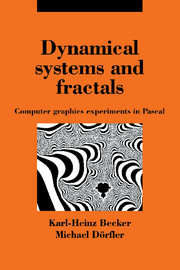Book contents
- Frontmatter
- Contents
- Foreword: New Directions in Computer Graphics: Experimental Mathematics
- Preface to the German Edition
- 1 Researchers Discover Chaos
- 2 Between Order and Chaos: Feigenbaum Diagrams
- 3 Strange Attractors
- 4 Greetings from Sir Isaac
- 5 Complex Frontiers
- 6 Encounter with the Gingerbread Man
- 7 New Sights – new Insights
- 8 Fractal Computer Graphics
- 9 Step by Step into Chaos
- 10 Journey to the Land of Infinite Structures
- 11 Building Blocks for Graphics Experiments
- 12 Pascal and the Fig-trees
- 13 Appendices
- Index
12 - Pascal and the Fig-trees
Published online by Cambridge University Press: 30 March 2010
- Frontmatter
- Contents
- Foreword: New Directions in Computer Graphics: Experimental Mathematics
- Preface to the German Edition
- 1 Researchers Discover Chaos
- 2 Between Order and Chaos: Feigenbaum Diagrams
- 3 Strange Attractors
- 4 Greetings from Sir Isaac
- 5 Complex Frontiers
- 6 Encounter with the Gingerbread Man
- 7 New Sights – new Insights
- 8 Fractal Computer Graphics
- 9 Step by Step into Chaos
- 10 Journey to the Land of Infinite Structures
- 11 Building Blocks for Graphics Experiments
- 12 Pascal and the Fig-trees
- 13 Appendices
- Index
Summary
Some Are More Equal Than Others – Graphics on Other Systems
In this chapter we show you how to generate the same graphic of a Feigenbaum diagram on different computer systems. We have chosen the Feigenbaum diagram because it does not take as long to produce as, say, the Gingerbread Man. We will give a ‘Feigenbaum reference program’ for a series of types of computer, operating systems, and programming languages. Using it you can see how to embed your algorithms in the appropriate program.
Our reference picture is shown in Figure 12.1-1.
MS-DOS and PS/2 Systems
With IBM's change of direction in 1987, the world of IBM-compatibles and MS-DOS machines changed too. In future as well as MS-DOS there will be a new IBM standard: the OS/2 operating system. The programmer who wishes to develop his Gingerbread Man program on these computers can do so on both families. Turbo Pascal from the Borland company, version 3.0 or higher, is the system of choice. The only difficulties involve different graphics standards and different disk formats, but these should not be too great a problem for the experienced MS-DOS user. The new graphics standard for IBM, like that for the Macintosh II, is a screen of 640 × 480 pixels. Our reference picture has 320 × 200 pixels, corresponding to one of the old standards.
The experienced MS-DOS user will already be aware of the different graphics standards in the world of MS-DOS. It will be harder for beginners, because a program that uses graphics may run on computer X but not on computer Y, even though both are MS-DOS machines.
Information
- Type
- Chapter
- Information
- Dynamical Systems and FractalsComputer Graphics Experiments with Pascal, pp. 327 - 378Publisher: Cambridge University PressPrint publication year: 1989
